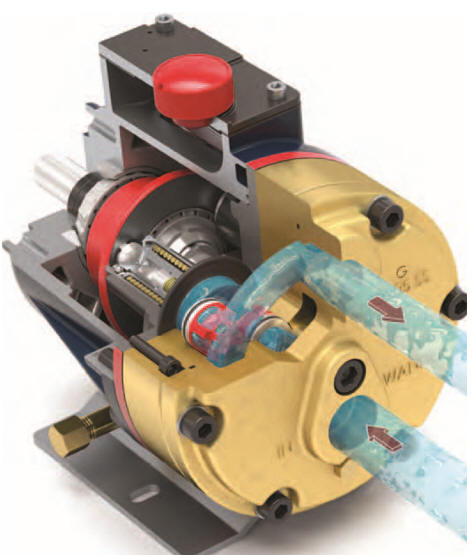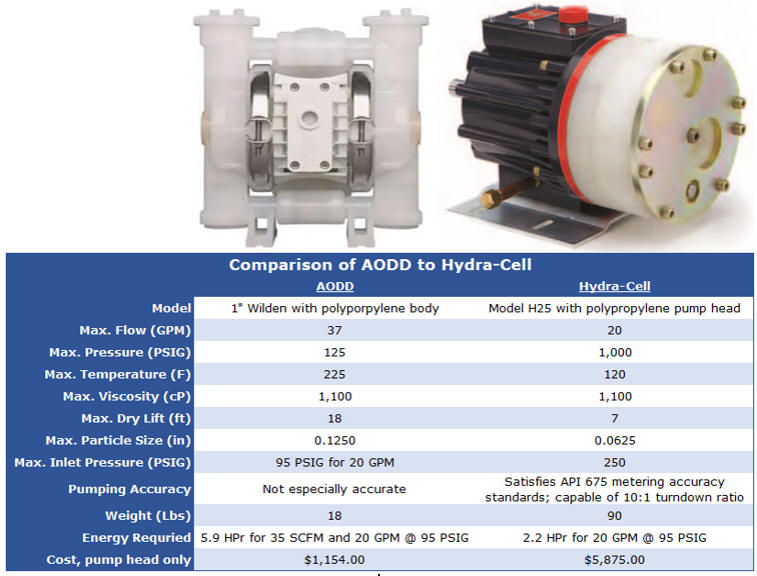Comparison: Air Operated Double Diaphragm Pump vs. Hydraulically Actuated Diaphragm Pump
 Comparing Hydra-Cell Hydraulically Actuated Diaphragm pumps to Air Operated
Double Diaphragm Pumps
Comparing Hydra-Cell Hydraulically Actuated Diaphragm pumps to Air Operated
Double Diaphragm Pumps
This article is the 2nd in a series comparing Wanner™ Hydra-Cell® Pro Pump pumps to other positive displacement pump designs; our first installment was in December 2022 comparing a Hydra-Cell P400 metering pump to a Zenith C-9000 gear pump. This month, we are comparing an air operated double diaphragm pump (AODD) to Wanners' hydraulically actuated diaphragm pump.
There is not much application overlap between the two pump designs; more often there are assumptions made about the Hydra Cell Pro design being similar to AODDs simply because both use diaphragms to move the process liquid. The designs are compared below to help customers better understand positive displacement pump designs to assist them with selecting the most appropriate pump design for their specific application.
There are few manufacturers of hydraulically actuated diaphragm pumps capable of relatively high flow rates and pressures; most of those other manufacturers specialize in low flow rate metering pump applications. If you describe the Hydra Cell Pro pump as simply a “diaphragm pump”, many customers immediately think of air operated double diaphragm pumps because they are ubiquitous to industrial liquid transfer applications.
An AODD pump is pneumatically driven, almost always via compressed air. The quality of the compressed air is important because contaminants (particles, compressor oil, water) accelerate component wear and may directly reduce performance. AODD pump IOM manuals suggest dry air filtered to 5m referred to as “instrument quality air”. Thus, the first aspect to consider for an AODD pump application is do you have sufficient compressed air that is both relatively dry and clean?
The volume of compressed air required is noted by the manufacturer per pump model and both the desired flow rate and maximum operating pressure determine the cubic feet per minute (CFM) required. Sometimes you can increase efficiency by using an oversized pump.
The majority of AODD pumps are limited to <250 PSIG maximum discharge pressures and actually most applications are for discharge pressure <125 PSIG.
Hydra Cell Pro pumps do not require compressed air and can operate within a pressure range of 30 to 5,000 PSIG depending upon the pump model. Any application overlap between the two different pump designs happens within that 30-125 PSI range and sometimes customers figure-out their process would benefit from higher pressures than their AODD pumps or air compressors are capable of providing.
AODD and Hydra Cell Pro pumps operate on a similar principle which uses a diaphragm to increase and decrease the volume of a pump chamber with the flow path controlled from inlet to outlet using one way check valves.
Diaphragms
This is perhaps the number one differentiation between AODDs and Hydra Cell Pro pumps: their diaphragm actuation method.
Diaphragms used in AODD pumps are pushed forward and pulled backwards due to compressed air pushing against a piston and relieving the air behind the diaphragm. A single piston is attached to both diaphragms, one diaphragm per pump chamber. Each pump chamber has a ball check valve to control the flow path from the inlet manifold to the outlet manifold. The compressed air pushes one diaphragm forward causing the piston to pull the other diaphragm backwards. The forward stroke reduces the pump chamber volume pushing liquid into the outlet manifold and the backwards stroke increases the pump chamber volume allowing liquid to fill the pump chamber.

The mid stroke happens when the air is relieved behind one diaphragm and directed to the other, during this time there is a brief interruption in flow which causes pulsation. The pulsation is particularly noticeable because the frequency of the diaphragm stroke is limited by the air valves, liquid ball/check valves and relatively long stroke of the piston; the maximum stroke frequency for a 1” 37 GPM AODD pump might be 8 pulses per second and usually it is much less.
Their design inherently contributes to mechanical fatigue of the diaphragm, resulting in rupture; such damage is accelerated at higher discharge pressures. Diaphragm ruptures equate to fugitive emissions (leakage via the air vent).
 Diaphragms
used in Hydra Cell Pro pumps are moved by a column of oil; oil is
non-compressible and thus acts just as a solid piston to move the diaphragm.
The (patented) benefit of using oil as your driving piston is that you can
control the mechanical stress across the diaphragm to within a maximum 2 DPSI. That means that the diaphragm never sees more than 2 PSI of
differential stress whether you are operating at 30 or 1,000 PSIG.
Diaphragms
used in Hydra Cell Pro pumps are moved by a column of oil; oil is
non-compressible and thus acts just as a solid piston to move the diaphragm.
The (patented) benefit of using oil as your driving piston is that you can
control the mechanical stress across the diaphragm to within a maximum 2 DPSI. That means that the diaphragm never sees more than 2 PSI of
differential stress whether you are operating at 30 or 1,000 PSIG.
Place a Post-It or business card between your hands and press together really hard – did you damage or rip the paper? Don’t worry, it doesn’t mean you are weak, rather you equalized the pressure on each side of that thin paper, so it remained stress free and undamaged. This is essentially what Hydra Cell Pro hydraulically balanced diaphragm design does, ensures that diaphragms lead a stress-free life – we should all be so lucky!
While each design uses diaphragms to displace the liquid, all but one Hydra Cell Pro pump design has 3 to 5 diaphragms; with a 3 diaphragm design the pulsation frequency is very high compared to AODD pumps at 115 pulses per second. Hydra Cell Pro operate using a shorter stoke at much higher frequency’s resulting in a pulsation that is inconsequential – liquid filled pressure gauge pointers sit still whereas they jump around with AODD pumps.
It is difficult to damage a Hydra Cell Pro diaphragm, failure modes are over-pressurization, chemical/temperature incompatibility and foreign material lodged in the pump chamber (it could even be something like ice if the liquid is allowed to freeze within the pump head.) Damaged diaphragms tend to enable the synthetic motor oil within the hydraulic end to leak into the process fluid. Especially if the inlet pressure is high, some process liquid may enter the hydraulic end. Special oils for food contact and other chemically sensitive applications are available to mitigate contamination concerns. There are also devices which monitor the oil level for quicker detection of a damaged diaphragm.

Cost & Complexity
Hydra-Cell pumps cost significantly more than AODD pumps, they are about 5-7 times more expensive due to several factors:
-
pump design is “robust”
-
capable of pressure up to 1,000 PSIG
-
requires an electric motor, baseplate, shaft coupling with guard and pressure regulating valve.
Hydra Cell Pro pumps are also vastly more complex; they have many additional parts and require oil changes every few months of use.
AODD pumps are simple machines, they have few components however they often require accessories such as air filter/regulators, pulsation dampeners and flexible connections, contributing to cost and material compatibility limitations. While Hydra Cell Pro pumps require electric motors (compressed air isn’t “free”), most air compressors are less efficient than standard electric motors, thus requiring slightly more HP to operate an AODD pump. Sometimes customers will consider more expensive Hydra Cell Pro pumps because their existing air compressor system isn’t large enough and replacing or adding compressors would be more expensive than switching to Hydra Cell Pro pumps.
It might be cost effective to replace an AODD pump with a Hydra Cell Pro pump if the AODD pumps are frequently replaced or if the process itself benefits from its aforementioned differential characteristics.
Applications
AODD pumps excel at liquid transfer applications because they typically require lower pressures and flow rate linearity isn’t much of a concern. In addition, their dry suction lift capabilities are much higher than a comparable sized Hydra Cell Pro pump. AODD pumps are also a good design for hazardous environments because they do not require explosion-proof motors and electrical enclosures.
Hydra Cell Pro pumps are over-built for low pressure transfer applications; if the application requires smooth flow (coating applications) or benefits from controllable, linear and repeatable volumetric dosing then the Hydra Cell Pro design would be worth the additional cost. Compared to AODDs, Hydra Cell Pro are typically used for higher pressures, smoother flow rates and precise flow control, even in humid or cold environments. The Hydra Cell Pro design accepts higher inlet pressures and has an overall broader application range compared to AODD pumps.
The most common types of pumps Hydra Cell Pro pumps “compete” with are piston and plunger style pumps; the pumping action, capabilities and cost are comparable however the sealless Hydra Cell Pro design contributes to increased reliability and costs significantly less to maintain. Seals used for piston and plunger pumps require filtration within the range of 25-150µ whereas Hydra Cell Pro pumps only require a 420-3175µ fineness of filtration, making them more suitable for reclaimed or otherwise abrasive liquid applications.




